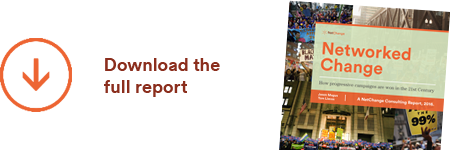This is the second in a three part series published in the Stanford Social Innovation Review.
So what’s the best way to manage digital at your organization? While no two organizations look the same, there are typically four models we’ve seen in our consulting experience: informal, centralized, independent, and hybrid. The first is typically a legacy of a poorly managed institution, the second and third get closer to what we think institutions need to sustain cultures of innovation, but it is really the fourth that can most consistently produce the integrated, customer-centric digital experience across all channels that is the holy grail of excellence in today’s world.
The most progressive organizations are learning to be like the web—they distribute digital staff across key departments, with a core group of experts that lead key initiatives, set up frameworks, and connect the dots while supporting others to lead. This organized but distributed leadership is known as the hybrid model. Unfortunately, this model is extremely challenging to pull off in strongly hierarchical institutions and requires collaborative leadership—thus, it is rare.
Here’s a look at the four models:
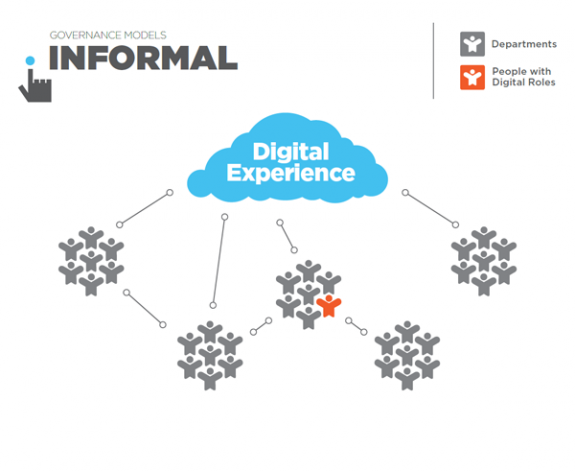
Informal is typically a legacy of how the Internet grew up organically in institutions: Program funding drives needs, and digital work is loosely and randomly dispersed across various functions and departments. The structure would more accurately be called un-managed, and is marked by an extreme lack of brand consistency, inefficiencies, and an overall rudderless strategy. Surprisingly, there are still institutions stuck in this pre-digital leadership stage. It’s not pretty.
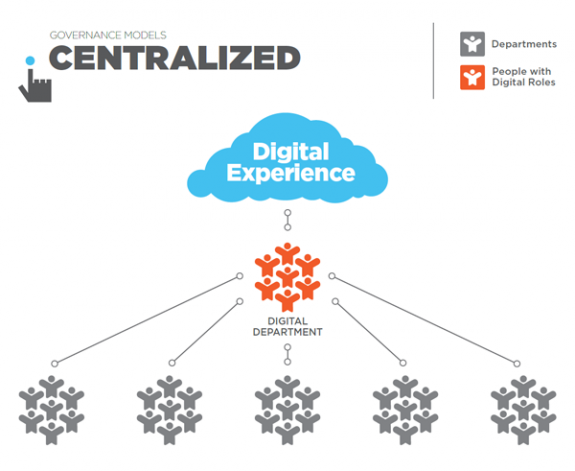
Centralized is a much more common model, as it fits well with how institutions have learned to manage other single-focus channels or functions, such as fundraising. They put digital in a silo (most often in communications), hire a smart person to run it, and serve the institution from this central place. The benefits are consistent messaging and branding, common tools, and, importantly, clear ownership and easy reporting lines. Unfortunately, these teams can be slow to respond to change, and get bogged down in heavy processes that stifle creativity from the fringes. These teams also typically have strong technical and publishing skills, but lack the ability (or, importantly, a mandate) to provide content leadership, design or usability services, and engagement with the constituents of the institution. These positions are typically low paid, low-level positions without much ability to shape how the institution uses digital strategically. This model makes for a cleanly run, professional system, but it does tend to make innovation difficult, especially around adding capacity for increasingly mission-critical functions such as storytelling and engagement.
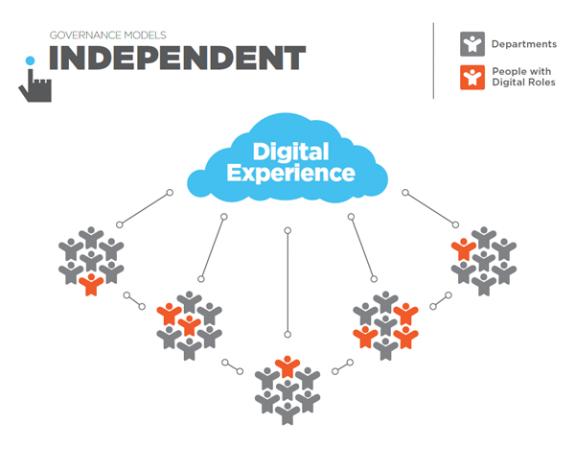
Independent is a less common model, but it appears to be where many institutions are headed, which is a little concerning. This model sees multiple centers of digital leadership established, with digital roles sprinkled throughout the institution. It is unfortunately somewhat random: Some departments run high-performing digital silos (often with their own brands, sites, and social networks) that are “protected” or isolated from the rest of the institution, while others with less clout struggle to get the attention of an over-taxed and under-resourced central digital team. This model can create a competitive rather than collaborative culture, can end up duplicating resources, and—with no strong digital services group looking after the whole and how it all fits together for the audience—can contribute to the confusing user experiences (with subsequent low actions and conversions) found on most institutional websites.
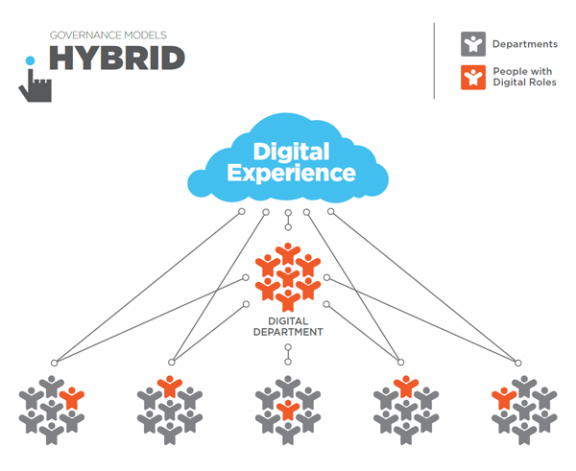
Hybrid is the most progressive and the most conducive to producing continuous innovation at the pace of digital change. In this model, different business units continue to build their own capacity based on their specific needs, but all digital staffers are connected to and supported by a central and strong digital experience team that directs the whole system toward long-term strategic goals. With this model, the culture of the central digital team is practicing what we’ll call “open leadership”: service oriented, highly collaborative, hyper-connected listeners, who also have the technical and content expertise to be high-value strategists. They take on leadership of high-leverage or high-risk projects themselves, but leave space for others to lead on their own initiatives. This may sound ideal, but in practice it is a more organic model than most institutions are comfortable with. It’s actually unclear whether this model can actually exist if the rest of the institution is highly silo-ized, politicized, and competitive. To be sustainable, support for this new type of collaborative leadership needs to come via a larger change initiative from the top that moves toward looser, more adaptive structures overall.
However your institution manages digital today, the best way to improve it is to first bring more awareness to how you currently manage digital. Find out by asking some tough questions: How well do your digital channels (web, email, social media, mobile) perform against your peers? Can you innovate fast enough? Do internal departments feel well served? Does the overall institution have a sense of purpose and direction with where digital is going?
Once you know where you stand, then you can aim to move away from the chaotic and unorganized informal model, or the rigid and often slow centralized model, and instead, move toward something more flexible and collaborative that’s suitable for our networked world. It takes time, but nailing the right structure and leadership for digital at your organization will likely have a much bigger impact on your overall performance than any other digital initiative you can undertake.
__
You can read the full post at the Stanford Social Innovation Review website. The article was co-written by myself, my senior strategy colleague at Communicopia Christopher Roy, and Michael Silberman who runs the new Global Digital Innovation Lab at Greenpeace.
Part one reviews the Five Dysfunctions of a Digital Team we’ve seen across our work with many clients. Part three will be the release of our Non-profit Digital Teams benchmark research.
Jason Mogus is Communicopia’s principal consultant and is the founder of Web of Change. He has been developing digital strategies for social change organizations for over 15 years. You can follow him at @mogusmoves.






